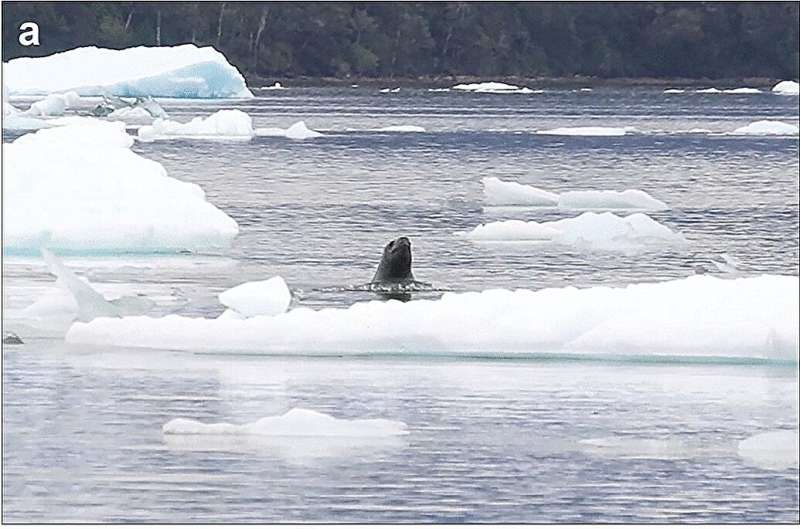This article has been reviewed according to Science X's editorial process and policies. Editors have highlighted the following attributes while ensuring the content's credibility:
fact-checked
peer-reviewed publication
trusted source
proofread
Research team observes courtship of leopard seals off the coast of South America

A study led by Baylor University biologist Sarah Kienle, Ph.D., and published in the journal Polar Biology has unveiled the first paired observations of sexual behavior and vocalizations in wild leopard seals. Kienle and her team's third published study on the mysterious leopard seal represents a major advance in understanding the behavior of one of the most difficult apex predators to study on Earth.
Kienle and her team observed a two-hour courtship interaction between a male and female leopard seal in Laguna San Rafael, Chile, and documented a range of behaviors and vocalizations, highlighting the complexity of leopard seal courtship.
- The male leopard seal produced 65 underwater calls, primarily low- and high-double trills, directed at the female.
- The female made seven in-air calls, including thump pulses, noseblasts and growls.
- The observed behaviors and vocalizations suggest a complex courtship process involving both in-air and underwater communication.
The female primarily remained on ice, producing in-air calls, while the male engaged in underwater vocalizations, seemingly directed toward the female. These findings provide new insights into the reproductive biology of this elusive species, previously known only from sparse observations and captive studies.
"This study marks a significant step forward in our understanding of leopard seal behavior in the wild. The detailed observations of courtship behaviors and vocal interactions offer a unique glimpse into the reproductive strategies of these solitary animals," said Kienle, who leads the Comparative Ecophysiology of Animals Lab (CEAL) at Baylor that focuses on understanding how different animals work in the context of their (often changing) environment.
This research not only enhances understanding of leopard seal biology but also underscores the importance of continued study and conservation efforts for these remarkable marine predators.
"Leopard seals are important Southern Ocean predators; understanding their reliance on sea ice and the drivers of reproductive success within and between populations is crucial for predicting how this species is—and will—respond to rapidly changing conditions across the southern hemisphere," Kienle said.
With the study showing that leopard seal sexual behaviors occur in Laguna San Rafael, the researchers show that leopard seals are breeding in South America.
"More broadly, these observations of sexual behavior and leopard seal pups in South America correspond with a recent review of sightings of leopard seal births and pups, which showed most sightings of newborns and pups occurred outside Antarctica," the researchers noted. "These data provide additional evidence that leopard seals can—and are—breeding outside of Antarctic pack ice."
The researchers hope to expand upon these findings in the future, including the need to collect paired in-air and underwater acoustic and video data of known sex individuals to better understand the role of competition, territoriality and female choice in the mating behavior of leopard seals.
First-of-its-kind research
Kienle and her colleagues published their initial—and first-of-its-kind—study on leopard seals in 2022 in the journal Frontiers in Marine Science, in which they showed that leopard seals have flexible movement patterns and dive behaviors. This variability may offer leopard seals the resilience needed to survive the extreme climate and environmental disturbances occurring around Antarctica and beyond.
In 2023, the team published a second study in Frontiers in Marine Science that focused on the stress physiology of leopard seals.
Led by Emily S. Sperou, a Baylor Ph.D. student in biology, the researchers examined how cortisol—an important stress hormone—varies between leopard seals. Their study also showed that leopard seals have the highest cortisol concentrations of any pinniped, including seals, sea lions and walruses.
More information: Sarah S. Kienle et al, First paired observations of sexual behavior and calls in wild leopard seals, Polar Biology (2024). DOI: 10.1007/s00300-024-03275-4
Journal information: Frontiers in Marine Science
Provided by Baylor University




















